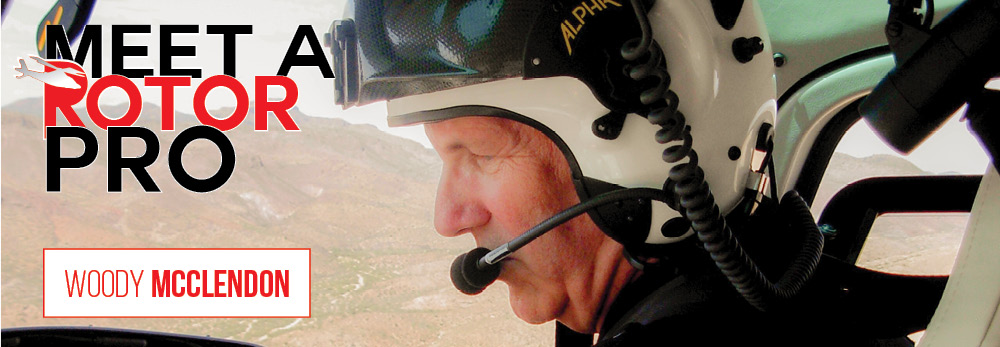|
Jul
17
2023
|
|
Posted 2 years 174 days ago ago by Admin
|
|

RPMN: What is your current position?
I'm North American new business manager for Loft Dynamics. My task is to introduce our new FSTD in the U.S. With my background at FlightSafety, I’m uniquely equipped to home in on specific helo markets who operate AS350s: public safety aviation, air medical, and commercial operators. They badly need an affordable AS350 simulator, and we have it.
RPMN: Tell me about your first flight or experience with helicopters.
My first flight was in a NASA Bell 47 hovering with doors-off at 5,000 AGL. I was with Boeing Flight Test and assigned to NASA-Langley (Virginia) on a flight research project. It was an off-day for the flight crew, so one of the NASA pilots asked if I wanted to go along on a flight. I’ll never forget sitting at 5,000 feet, shaking, and rattling while I stared down at the ground far, far below us.
RPMN: How did you get your start in helicopters?
I joined Hughes Helicopters in sales. They did my transition from airplanes to helos. Hughes hired me for my aeronautical and sales background, betting that I’d successfully make the transition to helicopters. I was the only guy they’ve ever hired since then who didn’t come with a helo background. I was successful and sold lots of 300s and 500s.
RPMN: When and how did you choose to fly or work on helicopters? Or did they choose you?
I pursued the Hughes sales opportunity because helicopters seemed like a good transition at the time. I’d had a couple of airplane jobs by then and didn’t feel like they were getting me anywhere. The commercial helo community was starting to blossom with the first generation of turbine models, and it seemed to me the sky was the limit. I think I was right on that.
RPMN: Where did you get your start flying or maintaining professionally?
I soloed when I was 16 (Piper Cub), and began instructing at age 19, I earned a B.S. in engineering, then I became a Boeing flight test engineer. After the initial excitement of working on NASA projects, I settled into the humdrum of engineering projects. It was a pace that was far too slow for me. That’s when I began to expand my horizons, and not long afterward, I made my connection with Hughes.
RPMN: If you were not in the helicopter industry, what else would you see yourself doing?
I was totally committed to flying, so it probably would have been some other airplane-related career. I’m convinced that Hughes was not only the right move but the best one for me at the time. The airplane business in those days was kind of in a state of paralysis that took years to overcome. By contrast, the helicopter world was where things were moving faster and faster.
RPMN: What do you enjoy doing on your days off?
I ride my bike and I hang out with my lady love of 44 years and hang with our son, Greg, and his three grandsons
RPMN: What is your greatest career accomplishment to date?
I suppose there have been a few along the way. Growing in the airplane business from Piper Navajos to Challenger 604s was a great experience, from 50-mile flights to trips across the Pacific and all over South America. Writing for Professional Pilot magazine opened a lot of doors for me along the way. I wrote for them for 20-some years: pilot reports on jets and helicopters as well as on lots of topics of interest. I’d say the latest career accomplishment is introducing the Loft Dynamics FSTD to the U.S. helicopter community. Sim training hasn’t been affordable for most of that group until Loft came along, so it’s exciting to be able to offer it now and hopefully save a lot of lives that would otherwise be lost to IIMC and other pilot-induced accidents.
RPMN: Have you ever had an “Oh, crap” moment in helicopters?
Several of them, mostly self-induced. Noteworthy one: I had been flying formation with a customer’s Bell 47, then did a hard left turn to head home. That hard turn ended up with me on my back. Had to take a deep breath and do the other half of a loop, VERY smoothly, without tearing the rotor off or blowing out the windshield. I did it.
RPMN: If you could give only one piece of advice to a new helicopter pilot or mechanic, what would it be?
For new pilots, find a mentor and learn aviation culture early. Even the best schools teach formal academics, which are vital to a student’s success for sure. But I still think there’s no substitute for the advice and counsel of a mentor. I had one early in my career; he taught me the fundamentals of flying that work for me to this day. I think a number of institutions are implementing mentorships.
RPMN: In your view, what is the greatest challenge for the helicopter industry at this moment in time?
Absorbing new technology has always been a struggle for helicopter pilots. Having come from the airplane business into helicopters, it was clear that rotorcraft were 20 years behind the airplane guys. When the first electronic flight instruments and advanced autopilots became standard in airplanes, most of the helo OEMs equipped their products with them. Yet, I saw so many instances when line pilots refused to use them, convinced their background from VFR UH-1s was all they ever needed. It’s better now, but there are still a lot of holdouts who remain suspicious of technology. Generationally, we’re getting there.
READ MORE ROTOR PRO: https://justhelicopters.com/Magazine
WATCH ROTOR PRO YOUTUBE CHANNEL: https://buff.ly/3Md0T3y
You can also find us on
Instagram - https://www.instagram.com/rotorpro1
Facebook - https://www.facebook.com/rotorpro1
Twitter - https://twitter.com/justhelicopters
LinkedIn - https://www.linkedin.com/company/rotorpro1